Farm Typology in the Berambadi Watershed (India): Farming Systems Are Determined by Farm Size and Access to Groundwater
Abstract
:1. Introduction
2. Materials and Methods
2.1. Case Study: Hydrological and Morphological Description of the Watershed
2.2. Survey Design and Sampling
2.3. Analysis Method
3. Variability and Spatialization of Farm Characteristics and Practices
3.1. Farm Structure
3.1.1. Household Characteristics
3.1.2. Land Holding
3.1.3. Livestock and Equipment
3.1.4. Labor
3.2. Farm Practices
3.2.1. Input Use
3.2.2. Crop Yield Performances
3.3. Water Management for Irrigation
3.3.1. Access to Irrigation
3.3.2. Borewells
3.3.3. Pumps and Access to Electricity
3.3.4. Farm Ponds
3.3.5. Irrigation Methods
3.4. Economic Performances of the Farm
3.4.1. Investment in Farm Structure
3.4.2. Cropping Systems’ Products and Expenses
3.4.3. Investment in Irrigation
4. Typology of Farms in the Berambadi Watershed
4.1. Characteristics of Farm Typology
4.2. Characteristics of the Farm Types
4.2.1. Farm Type 1: Large Diversified and Productivist Farms
4.2.2. Farm Type 2: Small and Marginal Rainfed Farms
4.2.3. Farm Type 3: Small Irrigable Marketing Farms
5. Discussion
6. Conclusions
Acknowledgments
Author Contributions
Conflicts of Interest
References
- Ragab, R.; Prudhomme, C. SW—Soil and Water. Biosyst. Eng. 2002, 81, 3–34. [Google Scholar] [CrossRef]
- Fishman, R.; Devineni, N.; Raman, S. Can improved agricultural water use efficiency save India’s groundwater? Environ. Res. Lett. 2015, 10, 84022. [Google Scholar] [CrossRef]
- Graveline, N. Economic calibrated models for water allocation in agricultural production: A review. Environ. Model. Softw. 2016, 81, 12–25. [Google Scholar] [CrossRef]
- Valverde, P.; de Carvalho, M.; Serralheiro, R.; Maia, R.; Ramos, V.; Oliveira, B. Climate change impacts on rainfed agriculture in the Guadiana river basin (Portugal). Agric. Water Manag. 2015, 150, 35–45. [Google Scholar] [CrossRef]
- Köbrich, C.; Rehman, T.; Khan, M. Typification of farming systems for constructing representative farm models: Two illustrations of the application of multi-variate analyses in Chile and Pakistan. Agric. Syst. 2003, 76, 141–157. [Google Scholar] [CrossRef]
- Duvernoy, I. Use of a land cover model to identify farm types in the Misiones agrarian frontier (Argentina). Agric. Syst. 2000, 64, 137–149. [Google Scholar] [CrossRef]
- Andersen, E.; Elbersen, B.; Godeschalk, F.; Verhoog, D. Farm management indicators and farm typologies as a basis for assessments in a changing policy environment. J. Environ. Manag. 2007, 82, 353–362. [Google Scholar] [CrossRef] [PubMed]
- Valbuena, D.; Verburg, P.H.; Bregt, A.K. A method to define a typology for agent-based analysis in regional land-use research. Agric. Ecosys. Environ. 2008, 128, 27–36. [Google Scholar] [CrossRef]
- Daloğlu, I.; Nassauer, J.I.; Riolo, R.L.; Scavia, D. Development of a farmer typology of agricultural conservation behavior in the American Corn Belt. Agric. Syst. 2014, 129, 93–102. [Google Scholar] [CrossRef]
- Poussin, J.C.; Imache, A.; Beji, R.; Le Grusse, P.; Benmihoub, A. Exploring regional irrigation water demand using typologies of farms and production units: An example from Tunisia. Agric. Water Manag. 2008, 95, 973–983. [Google Scholar] [CrossRef] [Green Version]
- Clavel, L.; Soudais, J.; Baudet, D.; Leenhardt, D. Integrating expert knowledge and quantitative information for mapping cropping systems. Land Use Policy 2011, 28, 57–65. [Google Scholar] [CrossRef]
- Pani, N. Institutions that cannot manage change: A Gandhian perspective on the Cauvery dispute in South India. Water Altern. 2009, 2, 315–327. [Google Scholar]
- Sekhar, M.; Rasmi, S.N.; Javeed, Y.; Gowrisankar, D.; Ruiz, L. Modelling the groundwater dynamics in a semi-arid hard rock aquifer influenced by boundary fluxes, spatial and temporal variability in pumping/recharge. Adv. Geosci. 2006, 4, 173–181. [Google Scholar]
- Javeed, Y.; Sekhar, M.; Bandyopadhyay, S.; Mangiarotti, S. EOF and SSA Analyses of Hydrological Time Series to Assess Climatic Variability and Land-Use Effects: A Case Study in the Kabini River Basin of South India; International Association of Hydrological Sciences Publication: Wallingford, CT, USA, 2009; pp. 167–177. [Google Scholar]
- Dorin, B.; Landy, F. Agriculture et Alimentation de l’Inde—Les Vertes Années (1947–2001); Institut National de Recherche Agronomique Editi.: Paris, France, 2002. [Google Scholar]
- Chandrasekaran, K.; Devarajulu, S.; Kuppannan, P. Farmers’ Willingness to Pay for Irrigation Water: A Case of Tank Irrigation Systems in South India. Water 2009, 1, 5–18. [Google Scholar] [CrossRef]
- Shah, T.; Giordano, M.; Mukherji, A. Political economy of the energy-groundwater nexus in India: Exploring issues and assessing policy options. Hydrogeol. J. 2012, 20, 995–1006. [Google Scholar] [CrossRef]
- Aubriot, O. Tank and Well Irrigation Crisis; Concept Pu.: New Delhi, India, 2013. [Google Scholar]
- Sekhar, M.; Javeed, Y.; Bandyopadhyay, S.; Mangiarotti, S.; Mazzega, P. Groundwater management practices and emerging challenges: Lessons from a case study in the Karnataka State of South India. In Groundwater Management Practices; CRC Press: Boca Raton, FL, USA, 2011; p. 436. [Google Scholar]
- Ruiz, L.; Sekhar, M.; Thomas, A.; Badiger, S.; Bergez, J.E.; Buis, S.; Corgne, S.; Riotte, J.; Raynal, H.; Bandhyopadhya, S.; et al. Adaptation of irrigated agriculture to climate change: Trans-disciplinary modelling of a watershed in South India. Proc. IAHS 2015, 366, 137–138. [Google Scholar] [CrossRef]
- Venot, J.-P.; Reddy, V.R.; Umapathy, D. Coping with drought in irrigated South India: Farmers’ adjustments in Nagarjuna Sagar. Agric. Water Manag. 2010, 97, 1434–1442. [Google Scholar] [CrossRef]
- BVET. Available online: http://bvet.obs-mip.fr/en (accessed on 11 January 2017).
- Sekhar, M.; Riotte, J.; Ruiz, L.; Jouquet, J.; Braun, J.J. Influences of Climate and Agriculture on Water and Biogeochemical Cycles: Kabini Critical Zone Observatory. Proc. Indian Natl. Sci. Acad. 2016, 82, 833–846. [Google Scholar] [CrossRef]
- Tomer, S.; Al Bitar, A.; Sekhar, M.; Zribi, M.; Bandyopadhyay, S.; Sreelash, K.; Sharma, A.K.; Corgne, S.; Kerr, Y. Retrieval and Multi-scale Validation of Soil Moisture from Multi-temporal SAR Data in a Semi-Arid Tropical Region. Remote Sens. 2015, 7, 8128–8153. [Google Scholar] [CrossRef]
- Barbiéro, L.; Parate, H.R.; Descloitres, M.; Bost, A.; Furian, S.; Mohan Kumar, M.S.; Kumar, C.; Braun, J.-J. Using a structural approach to identify relationships between soil and erosion in a semi-humid forested area, South India. Catena 2007, 70, 313–329. [Google Scholar] [CrossRef] [Green Version]
- Maréchal, J.-C.; Vouillamoz, J.-M.; Mohan Kumar, M.S.; Dewandel, B. Estimating aquifer thickness using multiple pumping tests. Hydrogeol. J. 2010, 18, 1787–1796. [Google Scholar] [CrossRef] [Green Version]
- Dewandel, B.; Perrin, J.; Ahmed, S.; Aulong, S.; Hrkal, Z.; Lachassagne, P.; Samad, M.; Massuel, S. Development of a tool for managing groundwater resources in semi-arid hard rock regions: Application to a rural watershed in South India. Hydrol. Process. 2010, 24, 2784–2797. [Google Scholar] [CrossRef]
- Perrin, J.; Ahmed, S.; Hunkeler, D. The effects of geological heterogeneities and piezometric fluctuations on groundwater flow and chemistry in a hard-rock aquifer, southern India. Hydrogeol. J. 2011, 19, 1189–1201. [Google Scholar] [CrossRef]
- Shah, T.; Ul Hassan, M.; Khattak, M.Z.; Banerjee, P.S.; Singh, O.P.; Rehman, S.U. Is Irrigation Water Free? A Reality Check in the Indo-Gangetic Basin. World Dev. 2009, 37, 422–434. [Google Scholar] [CrossRef]
- González Botero, D.; Bertran Salinas, A. Assessing Farmers’ Vulnerability to Climate Change: A Case Study in Karnataka, India; Universitat Autonoma de Barcelone: Barcelona, Spain, 2013. [Google Scholar]
- Srinivasan, V.; Thompson, S.; Madhyastha, K.; Penny, G.; Jeremiah, K.; Lele, S. Why is the Arkavathy River drying? A multiple-hypothesis approach in a data-scarce region. Hydrol. Earth Syst. Sci. 2015, 19, 1905–1917. [Google Scholar] [CrossRef]
- Levy, P.S.; Lemeshow, S. Sampling of Populations: Methods and Applications; John Wiley: New York, NY, USA, 2013. [Google Scholar]
- Laoubi, K.; Yamao, M. A typology of irrigated farms as a tool for sustainable agricultural development in irrigation schemes. Int. J. Soc. Econ. 2009, 36, 813–831. [Google Scholar] [CrossRef]
- Rossi, P.; Wright, J.; Anderson, A. Handbook of Survey Research Quantitative Studies in Social Relations. 2013. Available online: http://www.sciencedirect.com/science/book/9780125982269 (accessed on 11 January 2017).
- Cochran, W. Sampling Techniques; John Wiley: London, UK, 1953. [Google Scholar]
- R Core Team. R: A Language and Environment for Statistical Computing; R Foundation for Statistical Computing: Vienna, Austria, 2013. [Google Scholar]
- Husson, F.; Lê, S.; Pagès, J. Exploratory Multivariate Analysis by Example Using R; CRC Press: Boca Raton, FL, USA, 2010. [Google Scholar]
- Le Roux, B.; Rouaner, H. Geometric Data Analysis: From Correspondence Analysis to Structured Data Analysis; Springer: London, UK, 2004. [Google Scholar]
- Di Franco, G. Multiple correspondence analysis: One only or several techniques? Qual. Quant. 2016, 50, 1299–1315. [Google Scholar] [CrossRef]
- Kristensen, L.S.; Thenail, C.; Kristensen, S.P. Landscape changes in agrarian landscapes in the 1990s: The interaction between farmers and the farmed landscape. A case study from Jutland, Denmark. J. Environ. Manag. 2004, 71, 231–244. [Google Scholar] [CrossRef] [PubMed]
- Kaufman, L.; Rousseeuw, P.J. Finding Groups in Data: An Introduction to Cluster Analysis; John Wiley: New York, NY, USA, 2009. [Google Scholar]
- Omran, M.; Engelbrecht, A.; Salman, A. An overview of clustering methods. Intell. Data Anal. 2007, 11, 583–605. [Google Scholar]
- Paul, S.; Chakravarty, R. Constraints in Role Performance of Gram Panchayat in Agriculture and Dairy Farming. Indian Res. J. Ext. Educ. 2016, 9, 29–31. [Google Scholar]
- Meyer, C. Dictionnaire des Sciences Animales. Montpellier, France, CIRAD. 2016. Available online: http://dico-sciences-animales.cirad.fr/ (accessed on 27 September 2016).
- Norusis, M. Cluster Analysis. In IBM SPSS Statistics 19 Statistical Procedures Companion; 2012; Available online: http://www.norusis.com/pdf/SPC_v13.pdf (accessed on 11 January 2017).
- Goswami, R.; Chatterjee, S.; Prasad, B. Farm types and their economic characterization in complex agro-ecosystems for informed extension intervention: Study from coastal West Bengal, India. Agric. Food Econ. 2014, 2. [Google Scholar] [CrossRef] [Green Version]
- Milán, M.J.; Bartolomé, J.; Quintanilla, R.; García-Cachán, M.D.; Espejo, M.; Herráiz, P.L.; Sánchez-Recio, J.M.; Piedrafita, J. Structural characterisation and typology of beef cattle farms of Spanish wooded rangelands (dehesas). Livest. Sci. 2006, 99, 197–209. [Google Scholar] [CrossRef]
- Senthilkumar, K.; Bindraban, P.S.; de Ridder, N.; Thiyagarajan, T.M.; Giller, K.E. Impact of policies designed to enhance efficiency of water and nutrients on farm households varying in resource endowments in south India. NJAS—Wagening. J. Life Sci. 2012, 59, 41–52. [Google Scholar] [CrossRef]
- Chandrasekhar, S.; Das, M.; Sharma, A. Short-term Migration and Consumption Expenditure of Households in Rural India. Oxford Dev. Stud. 2015, 43, 105–122. [Google Scholar] [CrossRef]
- Deshingkar, P.; Start, D. Seasonal Migration for Livelihoods in India: Coping, Accumulation and Exclusion; Overseas Development Institute: London, UK, 2003; Available online: http://164.100.154.90/files/migration.pdf (accessed on 11 January 2017).
- Dodd, W.; Humphries, S.; Patel, K.; Majowicz, S.; Dewey, C. Determinants of temporary labour migration in southern India. Asian Popul. Stud. 2016, 12, 294–311. [Google Scholar] [CrossRef]
- Chandra, B. India after Independance: 1947–2000; Penguin: London, UK, 2000. [Google Scholar]
- Bassi, N. Assessing potential of water rights and energy pricing in making groundwater use for irrigation sustainable in India. Water Policy 2014, 16, 442–453. [Google Scholar] [CrossRef]
- Ballukraya, P.N.; Sakthivadivel, R. Over-exploitation and artificial recharging of hard-rock aquifers of South India: Issues and options. In IWMI-TATA Water Policy Research Program Annual Partners’ Meeting, Vallabh Vidyanagar, Gujarat, India, 2002; p. 14. Available online: http://www.iwmi.cgiar.org/iwmi-tata_html/PartnersMeet/pdf/011%20-%20Ballukraya.pdf?galog=no (accessed on 11 January 2017).
- Sivaramakrishnan, J.; Asokan, A.; Sooryanarayana, K.R.; Hegde, S.S.; Benjamin, J. Occurrence of Ground Water in Hard Rock Under Distinct Geological Setup. Aquat. Procedia 2015, 4, 706–712. [Google Scholar] [CrossRef]
- Senthilkumar, K.; Bindraban, P.S.; de Boer, W.; de Ridder, N.; Thiyagarajan, T.M.; Giller, K.E. Characterising rice-based farming systems to identify opportunities for adopting water efficient cultivation methods in Tamil Nadu, India. Agric. Water Manag. 2009, 96, 1851–1860. [Google Scholar] [CrossRef]
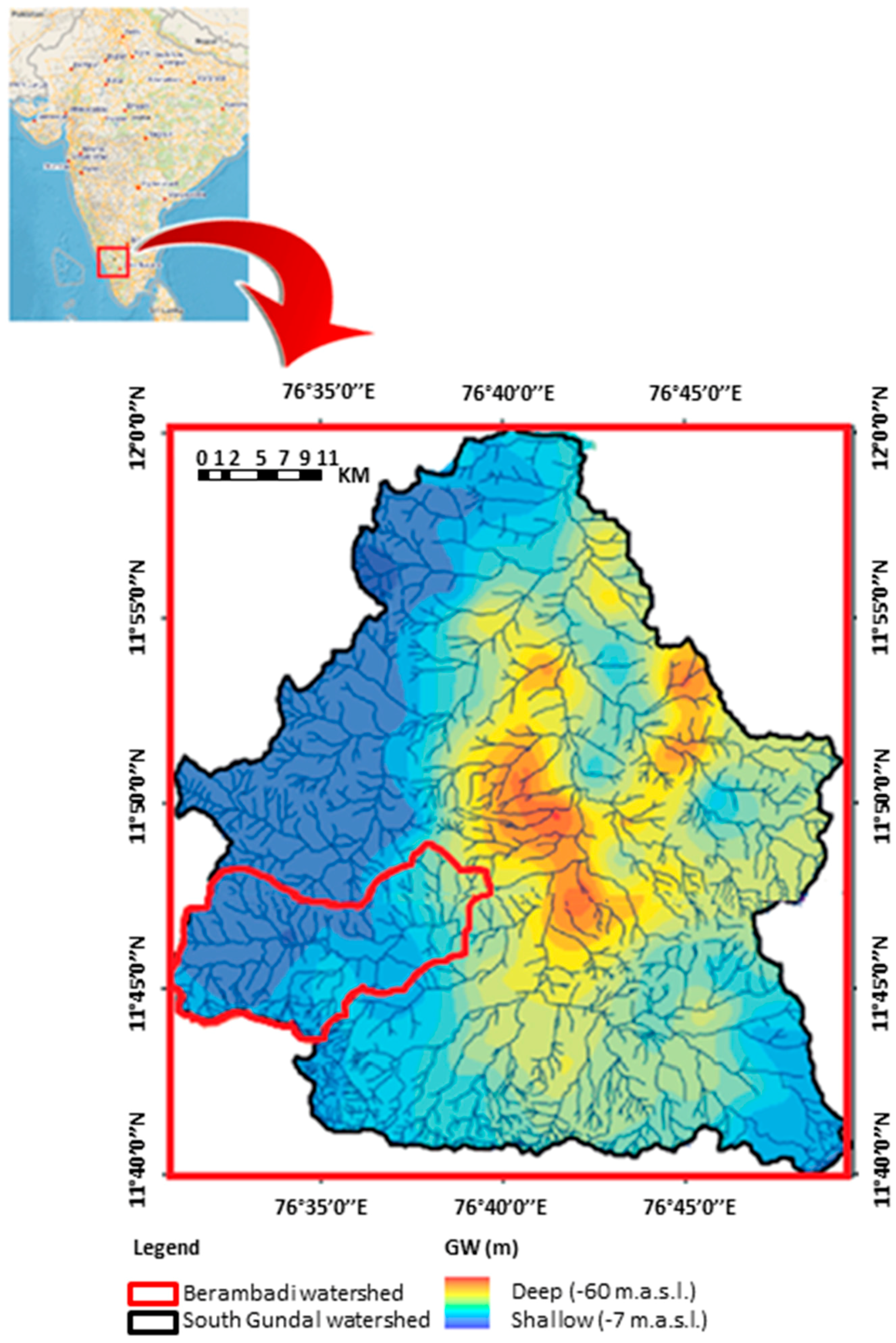

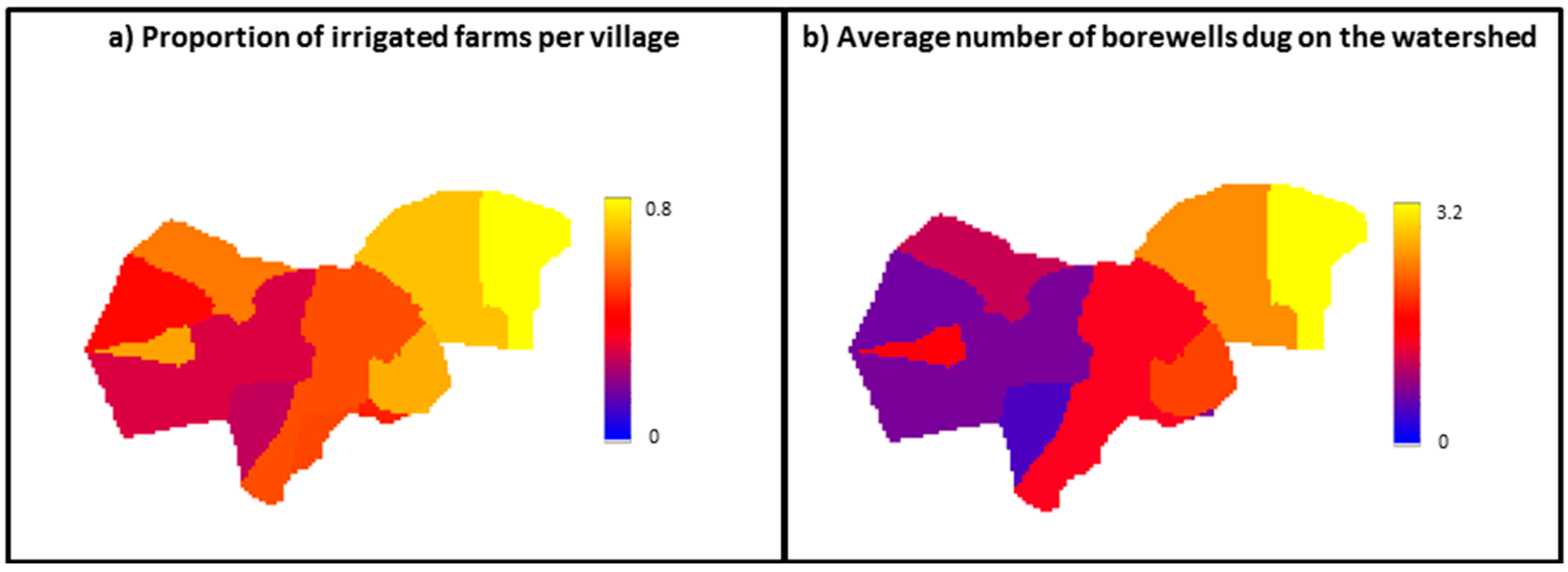
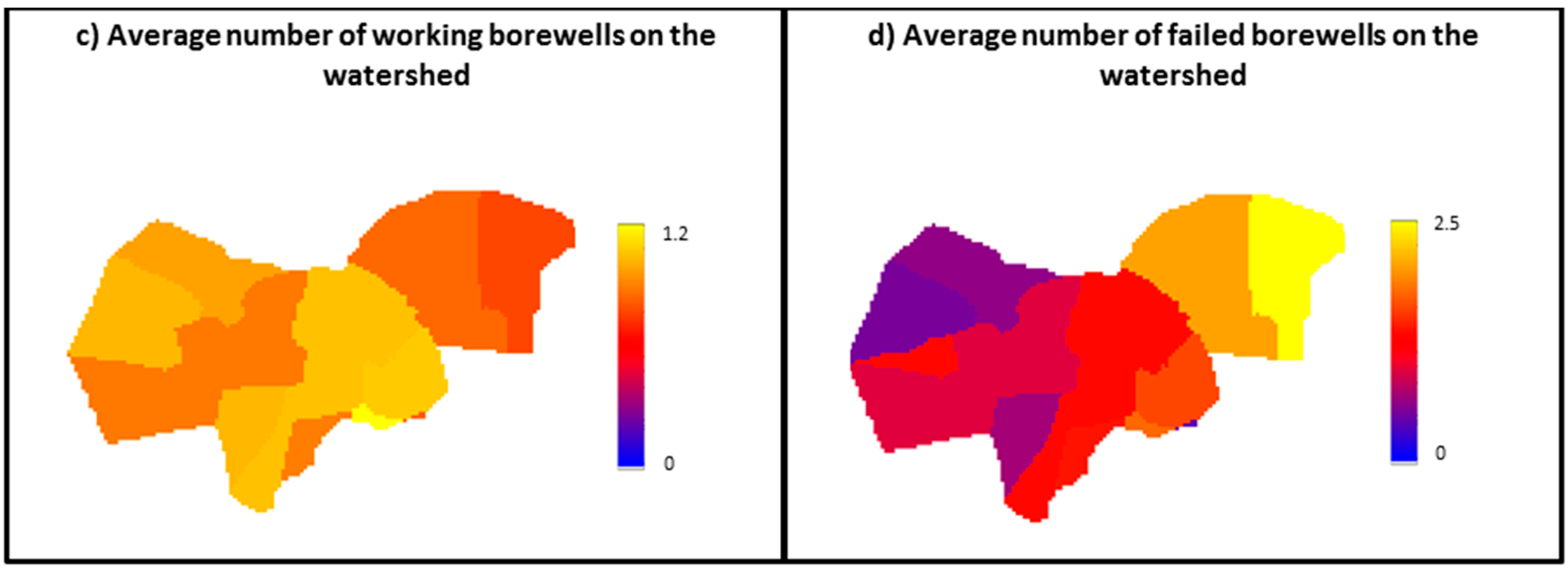
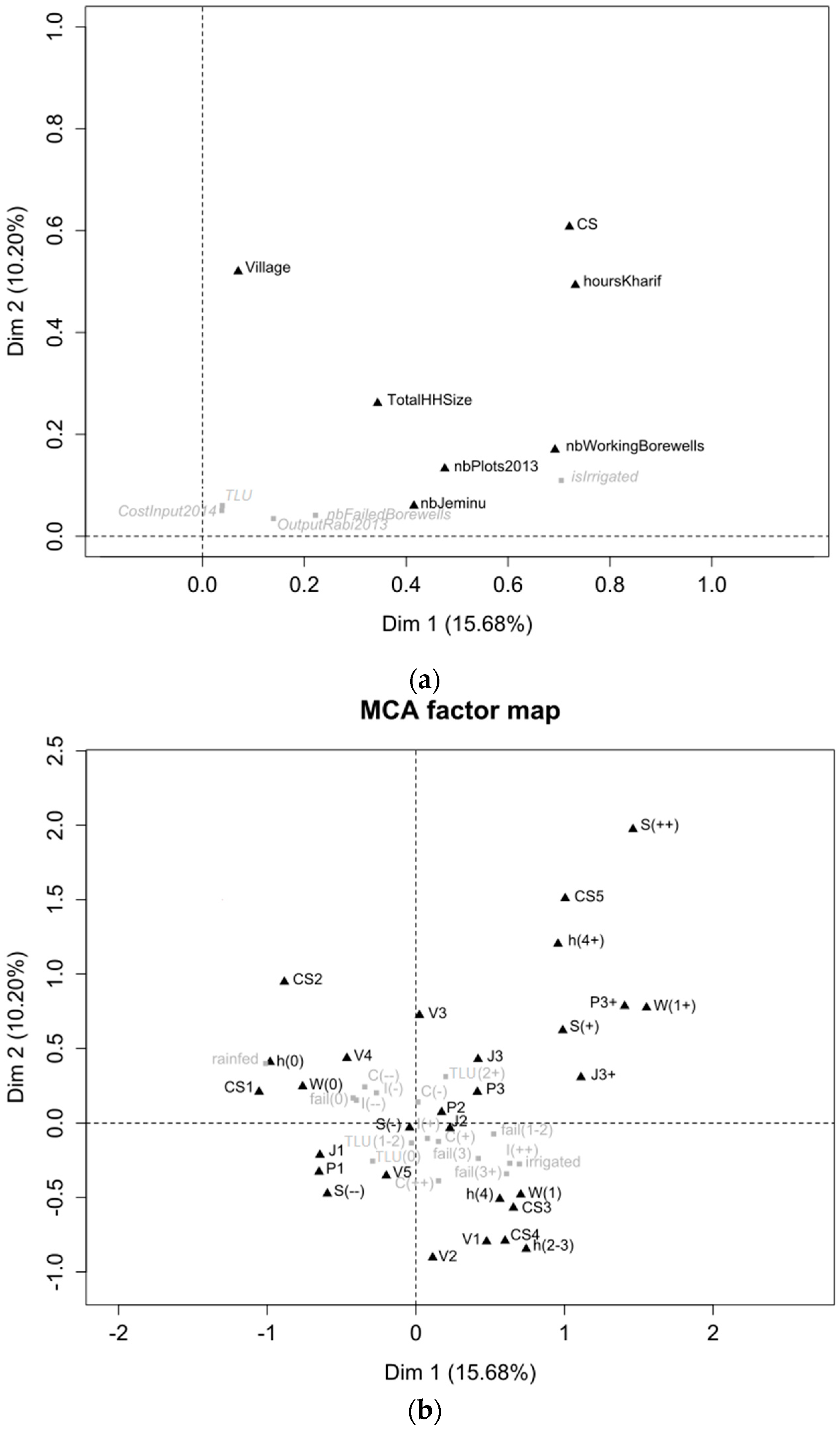
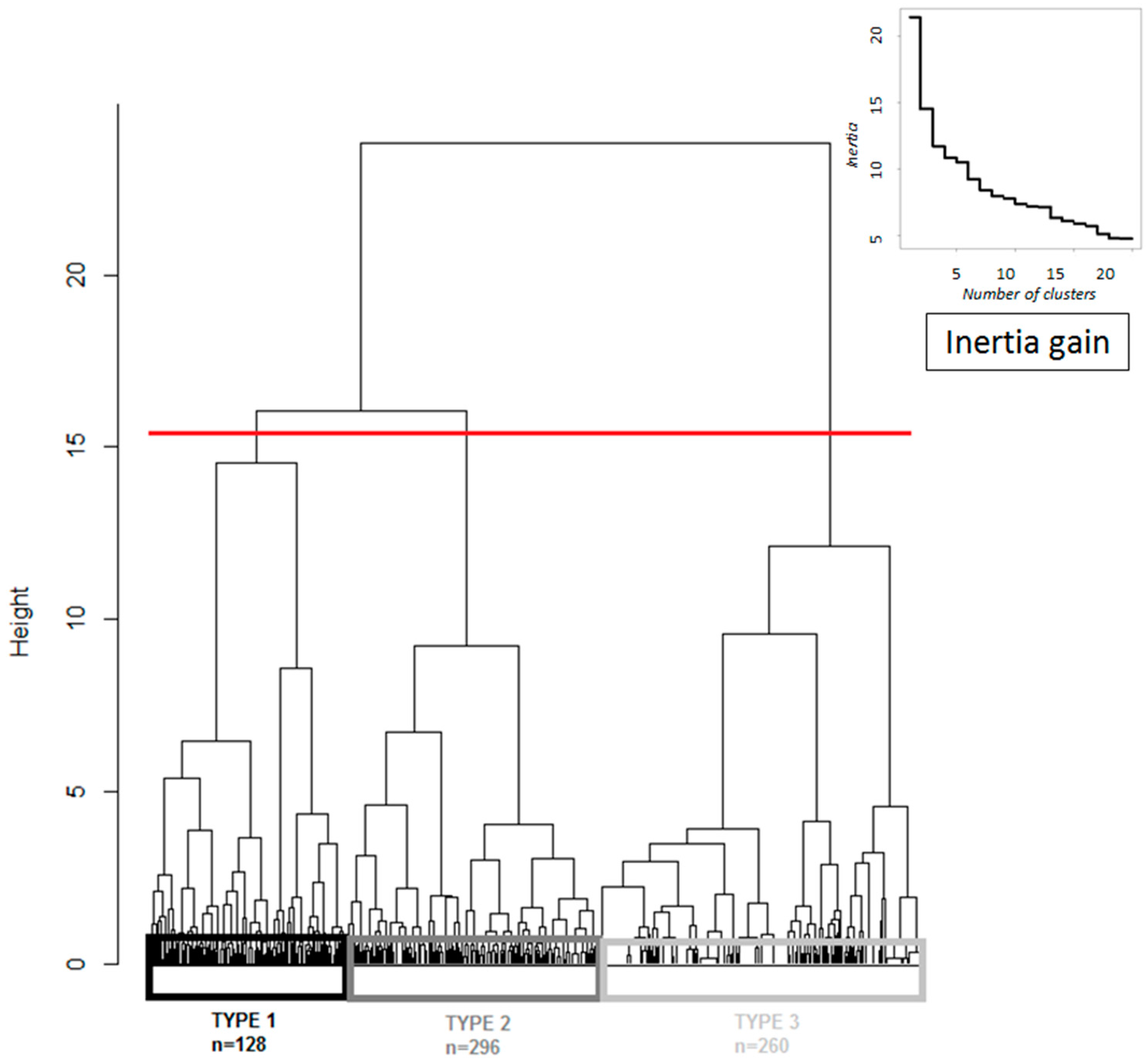
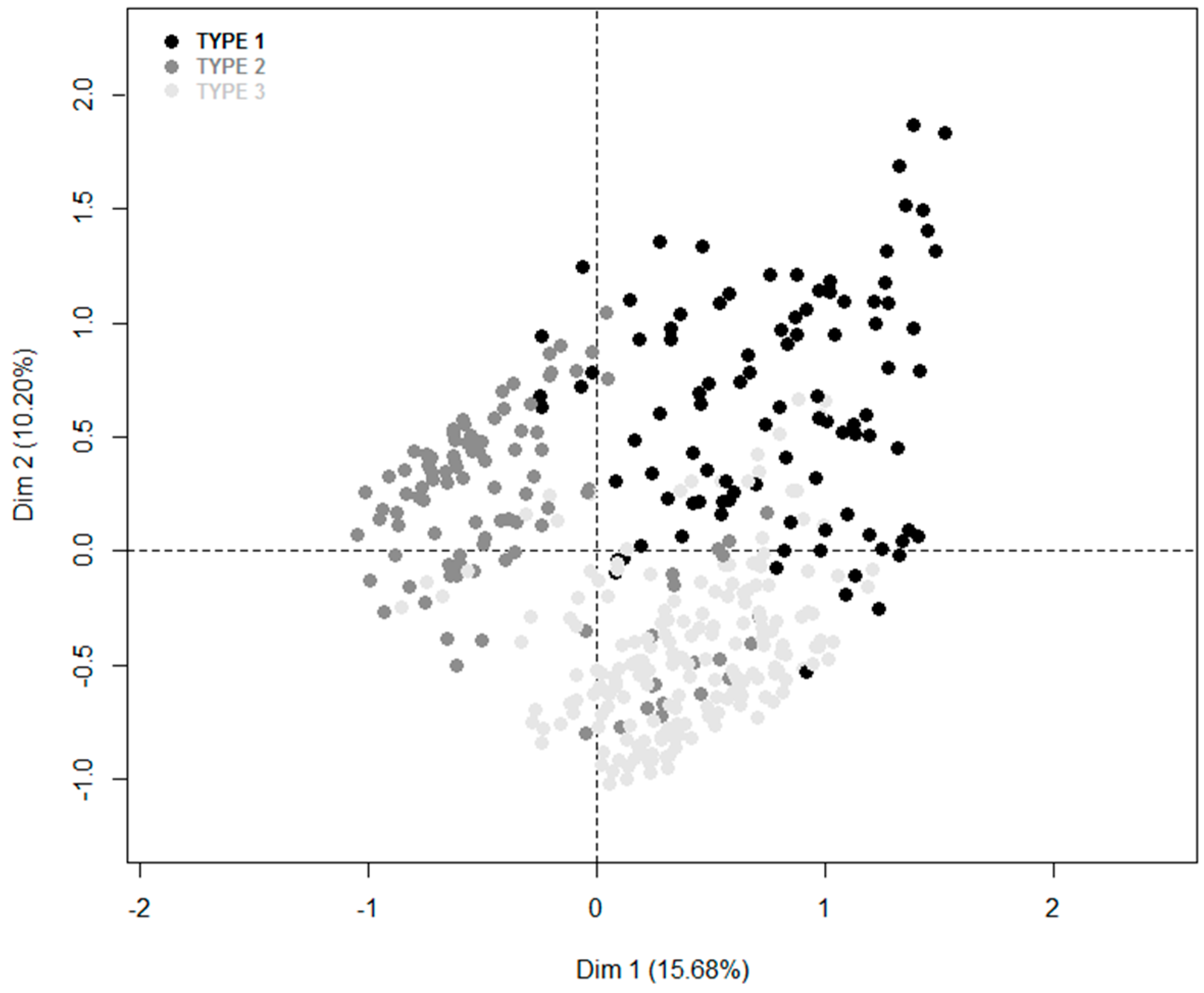

| Category | Code | Definition | Class | Abbreviation |
|---|---|---|---|---|
| Farming Context | ||||
| Spatial | village | Kuthanur | village 1 | V1 |
| Bheemanabeedu, Mallaianapura | village 2 | V2 | ||
| Kannagala, Gopalpura, Maddaiana Hundi, Haggadahalli, Hangala Hosahalli, Kallipura, Kunagahalli, Honnegowdanahal, Devarahalli | village 3 | V3 | ||
| Berambadi, Berambadi Colony, Navilgunda, Kaggalada Hundi, Bechanahalli, Lakkipura | village 4 | V4 | ||
| Maddur, Maddur Colony, Channamallipura | village 5 | V5 | ||
| Land resource | nbJeminu | number of plots (jeminu) of the farm | 1 jeminu | J1 |
| 2 jeminus | J2 | |||
| 3 jeminus | J3 | |||
| >3 jeminus | J3+ | |||
| nbPlot2013 | number of plots cultivated in 2013 | 1 plot | P1 | |
| 2 plots | P2 | |||
| 3 plots | P3 | |||
| >3 plots | P3+ | |||
| totalHHSize | total farm size in hectares | <0.8 hectares | S(--) | |
| [0.8 hectares; 2 hectares] | S(-) | |||
| [2 hectares; 4 hectares] | S(+) | |||
| >4 hectares | S(++) | |||
| Irrigation resource | isIrrigated | at least one jeminu irrigated | no | rainfed |
| yes | irrigated | |||
| nbWorkingBorewell | number of working borewells in 2014 | none | W(0) | |
| 1 borewell | W(1) | |||
| >1 borewell | W(1+) | |||
| nbFailedBorewell | number of failed borewells in 2014 | none | fail(0) | |
| 1–2 borewells | fail(1–2) | |||
| 3 borewells | fail(3) | |||
| >3 borewells | fail(3+) | |||
| hoursKharif | number of hours of electricity per day during kharif in 2014 | none | hours(0) | |
| [2 h; 3 h] | hours(2–3) | |||
| [3 h; 4 h] | hours(4) | |||
| [4 h; 8 h] | hours(4+) | |||
| Animal resource | TLU | number of livestock on the farm {oxen, bull, buffalo, cow} = 1, {sheep, goat} = 0.2 | none | TLU(0) |
| [0 TLU; 2 TLU] | TLU(1-2) | |||
| >2 TLU | TLU(2+) | |||
| Farm Performances | ||||
| Production costs | CostInput2014 | cost of farming per hectare during kharif in 2014 | [0 Rs–3700 Rs] | C(--) |
| [3700 Rs–7400 Rs] | C(-) | |||
| [7400 Rs–14,800 Rs] | C(+) | |||
| >14,800 Rs | C(++) | |||
| Production incomes | IncomeRabi2013 | income from selling crops per hectare during rabi in 2013 | [0 Rs–18,500 Rs] | I(--) |
| [18,500 Rs–37,000 Rs] | I(-) | |||
| [37,000 Rs–74,000 Rs] | I(+) | |||
| >74,000 Rs | I(++) | |||
| Farming Practices | ||||
| Cropping system | CS | type of cropping system in 2014 | rainfed, only cash crops | CS1 |
| rainfed, cash and subsistence crops | CS2 | |||
| irrigated, only cash crops | CS3 | |||
| irrigated and rainfed, only cash crops | CS4 | |||
| irrigated and rainfed, cash and subsistence crops | CS5 | |||
| Farm Type | TYPE 1 | TYPE 2 | TYPE 3 | |||||
|---|---|---|---|---|---|---|---|---|
| Category | Code | Class | Specificity | Homogeneity | Specificity | Homogeneity | Specificity | Homogeneity |
| Farming Context | ||||||||
| Spatial | village | V1 | 7% | 5% | 1% | 0% | 91% | 29% |
| V2 | 4% | 5% | 28% | 16% | 68% | 43% | ||
| V3 | 36% | 73% | 44% | 39% | 20% | 20% | ||
| V4 | 15% | 13% | 67% | 25% | 18% | 8% | ||
| V5 | 6% | 3% | 92% | 20% | 2% | 0% | ||
| Land resource | nbJeminu | J1 | 7% | 16% | 62% | 64% | 31% | 37% |
| J2 | 22% | 30% | 30% | 18% | 48% | 33% | ||
| J3 | 24% | 17% | 38% | 12% | 38% | 13% | ||
| J3+ | 43% | 36% | 16% | 6% | 41% | 17% | ||
| nbPlot2013 | P1 | 6% | 16% | 59% | 62% | 35% | 42% | |
| P2 | 19% | 20% | 36% | 17% | 46% | 25% | ||
| P3 | 18% | 21% | 36% | 18% | 46% | 26% | ||
| P3+ | 67% | 43% | 10% | 3% | 23% | 7% | ||
| totalHHSize | S(--) | 4% | 7% | 54% | 40% | 42% | 35% | |
| S(-) | 14% | 37% | 46% | 52% | 40% | 50% | ||
| S(+) | 44% | 39% | 23% | 9% | 33% | 14% | ||
| S(++) | 100% | 17% | 0% | 0% | 0% | 0% | ||
| Irrigation resource | isIrrigated | rainfed | 1% | 3% | 94% | 88% | 5% | 5% |
| irrigated | 31% | 97% | 9% | 12% | 61% | 95% | ||
| nbWorkingBorewell | W(0) | 6% | 17% | 75% | 91% | 19% | 27% | |
| W(1) | 27% | 56% | 10% | 9% | 64% | 66% | ||
| W(1+) | 63% | 27% | 2% | 0% | 35% | 7% | ||
| nbFailedBorewell | fail(0) | 12% | 36% | 65% | 83% | 23% | 33% | |
| fail(1–2) | 31% | 31% | 17% | 7% | 52% | 26% | ||
| fail(3) | 21% | 11% | 21% | 5% | 59% | 15% | ||
| fail(3+) | 26% | 22% | 13% | 5% | 61% | 26% | ||
| hoursKharif | h(0) | 3% | 8% | 91% | 90% | 6% | 7% | |
| h(2–3) | 15% | 22% | 7% | 4% | 78% | 57% | ||
| h(4) | 15% | 14% | 9% | 4% | 75% | 34% | ||
| h(4+) | 86% | 56% | 7% | 2% | 7% | 2% | ||
| Animal resource | globalAU | AU(0) | 8% | 12% | 53% | 33% | 39% | 28% |
| AU(1–2) | 18% | 33% | 40% | 32% | 43% | 39% | ||
| AU(2+) | 28% | 55% | 40% | 34% | 33% | 32% | ||
| Farm Performances | ||||||||
| Production costs | CostInput2014 | C(--) | 14% | 17% | 54% | 28% | 32% | 18% |
| C(-) | 19% | 34% | 46% | 36% | 34% | 30% | ||
| C(+) | 21% | 31% | 39% | 26% | 40% | 30% | ||
| C(++) | 20% | 17% | 29% | 11% | 51% | 22% | ||
| Production incomes | OutputRabi2013 | I(--) | 13% | 15% | 56% | 27% | 30% | 17% |
| I(-) | 16% | 23% | 54% | 35% | 30% | 22% | ||
| I(+) | 20% | 32% | 41% | 28% | 39% | 31% | ||
| I(++) | 26% | 30% | 19% | 9% | 54% | 30% | ||
| Farming Practices | ||||||||
| Cropping system | CS | CS1 | 1% | 2% | 92% | 65% | 7% | 5% |
| CS2 | 3% | 2% | 97% | 24% | 0% | 0% | ||
| CS3 | 17% | 9% | 10% | 4% | 73% | 38% | ||
| CS4 | 17% | 10% | 11% | 7% | 72% | 53% | ||
| CS5 | 87% | 53% | 1% | 0% | 12% | 3% | ||
© 2017 by the authors; licensee MDPI, Basel, Switzerland. This article is an open access article distributed under the terms and conditions of the Creative Commons Attribution (CC-BY) license (http://creativecommons.org/licenses/by/4.0/).
Share and Cite
Robert, M.; Thomas, A.; Sekhar, M.; Badiger, S.; Ruiz, L.; Willaume, M.; Leenhardt, D.; Bergez, J.-E. Farm Typology in the Berambadi Watershed (India): Farming Systems Are Determined by Farm Size and Access to Groundwater. Water 2017, 9, 51. https://doi.org/10.3390/w9010051
Robert M, Thomas A, Sekhar M, Badiger S, Ruiz L, Willaume M, Leenhardt D, Bergez J-E. Farm Typology in the Berambadi Watershed (India): Farming Systems Are Determined by Farm Size and Access to Groundwater. Water. 2017; 9(1):51. https://doi.org/10.3390/w9010051
Chicago/Turabian StyleRobert, Marion, Alban Thomas, Muddu Sekhar, Shrinivas Badiger, Laurent Ruiz, Magali Willaume, Delphine Leenhardt, and Jacques-Eric Bergez. 2017. "Farm Typology in the Berambadi Watershed (India): Farming Systems Are Determined by Farm Size and Access to Groundwater" Water 9, no. 1: 51. https://doi.org/10.3390/w9010051






